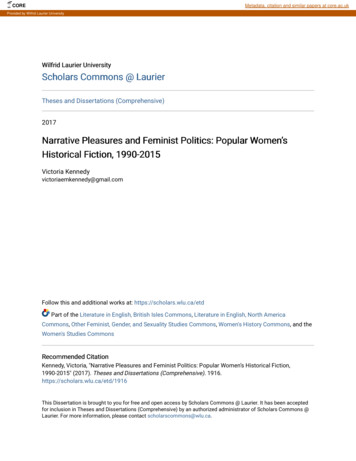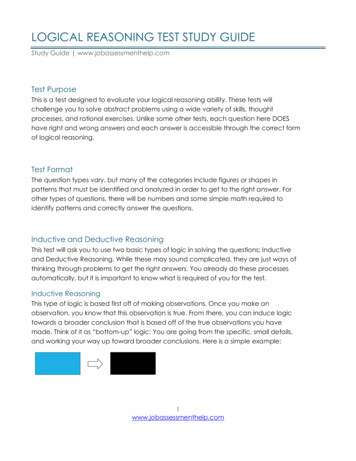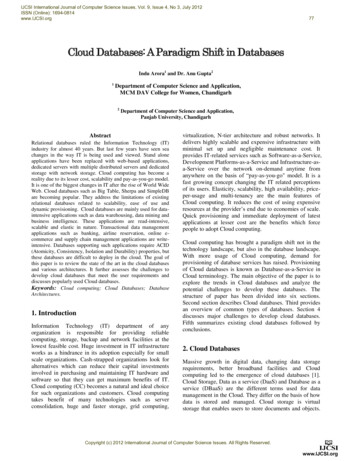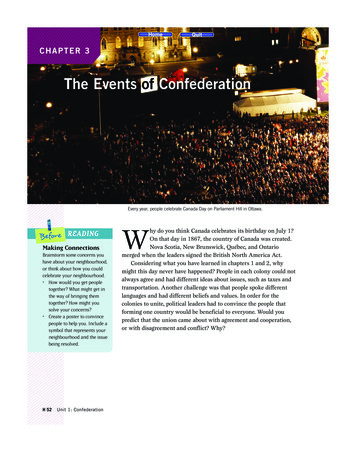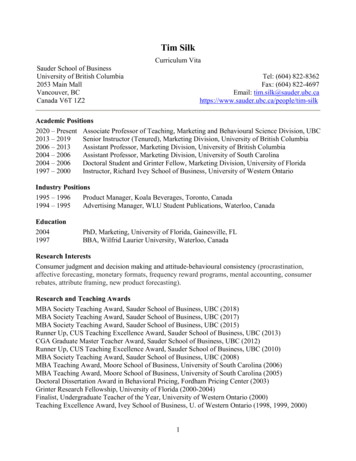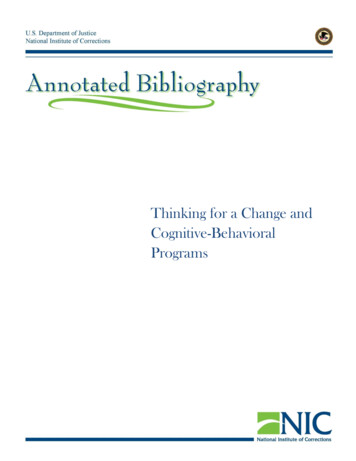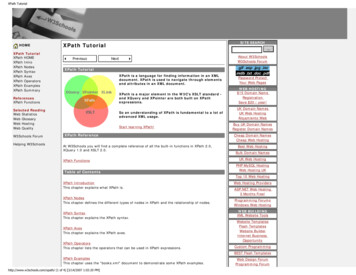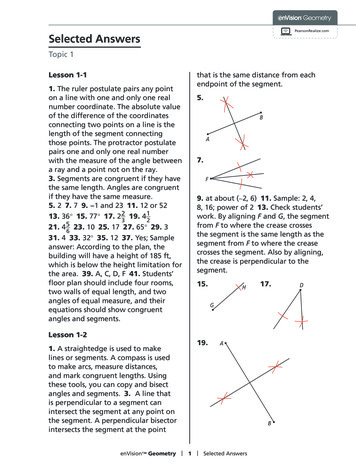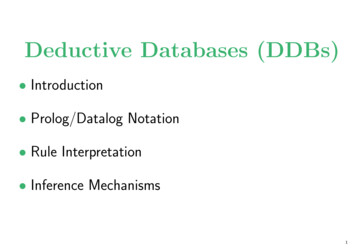
Transcription
Deductive Databases (DDBs) Introduction Prolog/Datalog Notation Rule Interpretation Inference Mechanisms1
Introduction1. DDBs is an area at the intersection of databases, AI, logic2. a DDB is a database system including capabilities to define deductive rules, viawhich we can deduce or infer additional information from the facts stored in adatabase3. theoretical foundation for DDBs is mathematical logic4. other types of systems (e.g. expert database systems or knowledge-basedsystems) also incorporate reasoning and inference capabilities5. common characteristic: use of AI techniques (production systems)6. difference: DDBs makes use of data in secondary storage, expert database systemsassume that the data needed resides in main memory2
Basic Notions of DDBsIn a DDB we specify rules through a declarative language (what, not how, e.g.SQL)An inference engine or deduction mechanism in the DDB can deduce newfacts from the database by interpreting these rulesmodel used for DDBs is closely related to:1. Relational Data Model (domain relational calculus)2. logic programming, Prolog languagea variation of Prolog, Datalog is used to define rules declaratively.the existing set of relations is treated as a set of literals in the languageDatalog syntax is similar to Prolog syntaxDatalog semanticsa 6 Prolog semanticsa howprograms are executed3
a DDB uses two main types of specifications: facts and rules1. Facts are specified in a manner similar to relations, but not necessarily includingattribute names.In a DDB the meaning of an attribute is determined by its position in a tuple2. Rules are similar to relational views.They specify virtual relations that are not actually stored but rather can bededuced from the facts by applying inference mechanisms based on the rulespecificationsMain difference between rules & views is that rules can involve recursionThe evaluation of Prolog programs is based on backward chaining, whichinvolves a top-down evaluation of goalsThe evaluation of Datalog programs is roughly based on bottom-up evaluationIn Prolog the order of specification of facts and rules and the order of literals aresignificant, for the evaluationin Datalog an effort has been made to circumvent these problems4
Prolog/Datalog NotationPrinciple: provide predicates with unique namesPredicate:implicit meaning (via a suggestive name)fixed number of argumentsIf the arguments are all constant values, then the predicate states that a certain fact istrue.If the arguments are variables, then the predicate is considered as a query or as a part ofa rule or constraintProlog Conventions adopted here:1. constant values in a predicate are either numeric or character strings and they arerepresented by identifiers starting with a lowercase letter only2. variable names start with an uppercase letter only5
Example based on the company database3 predicate names: supervise, superior, subordinatea) the supervise predicate:defined via a set of facts, each with two arguments: (supervisor name, supervisee name)supervise expresses the idea of direct supervisionfacts correspond to actual data stored in the databasefacts correspond to tuples in a relation with two attributes and schema:SUPERVISE(SUPERVISOR, SUPERVISEE)note the absence of attribute names in factsattributes are represented by position. 1st argument is the supervisor, 2nd argument isthe supervisee. supervise(X,Y) states the fact that X supervises Y.b) the superior, subordinate predicates:defined via a set of rules (superior allows us to express the idea of non-direct supervision)MAIN IDEA OF DDBsspecify rules and a framework to infer (deduce) new information based on these rules6
7
Rule Syntaxhead :- bodythe symbol :- is interpreted as IFF (if and only if)the head is also called LHS or conclusion. it is (usually) made up of a single predicatethe body is also called RHS or premise(s). its made up of one or more predicatesseparated by commas (implicitly connected by AND)predicates with constant arguments are called ground predicates or instantiatedpredicatesthe arguments of a predicate in a rule are (typically) variablesQuery SyntaxA query typically involves a predicate symbol with some variable arguments.The answer to a query is to deduce all different combinations of constant values, that(when assigned to the variables) make the predicate true.8
Datalog Notation A Datalog program is built from combining atomic formulas. Atomic formulas are literals of the form p(a1 , . . . , an ) where p is the predicate nameand n is the # of its arguments. n is called the arity or the degree of p The arguments can be constant values (lowercase) or variable names (uppercase). built-in predicates: (syntax: less(X,3), X 3). binary comparison , , , over ordered domains. binary comparison , / over ordered/unordered domains Attention to infinite ranges: greater(X,3) A literal is an atomic formula as defined earlier (positive literal) or an atomic formulaprecede by not (negative literal) Only formulas specified in a restricted clausal form called Horn clauses, can beused in Datalog.9
Clausal Form, Horn clausesA formula can contain predicates called atoms & quantifiers (universal , existential )In clausal form, a formula must be transformed into another formula with thefollowing characteristics: all variables in the formula are universally quantified. (since there is noneed to include explicitly, it is removed and all variables are implicitly quantified by ) the formula is made up of a number of clauses, each clause is a disjunction ofliterals (the literals are connected by OR) a formula is a conjunction of clauses (the clauses are connected by AND)It can be shown that any formula can be converted into clausal form.In Datalog, rules are expressed as a restricted form of clauses, called Horn clauses:they can contain at most one positive literal:. N OT (P1 ) OR N OT (P2 ) OR · · · OR N OT (PN ) OR Q. N OT (P1 ) OR N OT (P2 ) OR · · · OR N OT (PN )10
(1)N OT (P1 ) OR N OT (P2 ) OR · · · OR N OT (PN ) OR Qis equivalent to P1 AN D P2 AN D · · · AN D PN Qwhich is written in Datalog as the rule: Q : P1 , P2 , . . . , Pnthis rule says that if the predicates Pi are all true, for a particular binding of theirvariables, then Q is also true and can be deduced(2)N OT (P1 ) OR N OT (P2 ) OR · · · OR N OT (PN )is equivalent to P1 AN D P2 AN D · · · AN D PN which is written in Datalog as the rule: P1 , P2 , . . . , Pnthis rule can be considered as an integrity constraint11
Rule SemanticsA rule means that if a binding of constant values to the variables in the body (RHS) of arule makes all its predicates TRUE, then the same binding makes the head (LHS) TRUEA rule provides a way to generate new facts, instantiations of the head of the rule.These new facts are based on already existing facts, corresponding to bindings ofpredicates in the body of the ruleNote that listing multiple comma-separated predicates in the body or a rule, implicitlymeans that they are connected by ANDExample the superior predicate of the company database (direct/indirect X,Y):-supervise(X,Z),superior(Z,Y)NOTE 1: a rule may be defined recursivelyNOTE 2: when two (or more) rules have the same (LHS) head predicate, the headpredicate is true if the 1st body is TRUE OR if the 2nd body is TRUE12
Rule Interpretation2 main ways of interpreting the theoretical meaning of the rules:1. proof-theoretic interpretation2. model-theoretic interpretationIn practice, in specific systems, the inference mechanism defines the exactinterpretation and provides a computational interpretation of the meaning of the rules.Proof-theoretic interpretationFacts and rules are true statements or axioms. Ground axioms contain no variables.Facts are ground axioms that are taken to be true. Rules are called deductive axiomsbecause they can be used to deduce new facts.The deductive axioms are used to derive new facts from existing factsProvides a procedural approach to compute the answer to a Datalog query.13
14
Model-theoretic interpretationSpecify a (usually) finite domain of constant values.Assign to a predicate every possible combination of values as argumentsDetermine if the predicate is true or falseIn practice, we specify the combinations of argument values that make the predicatetrue and state that all other combinations make the predicate false. When this is donefor all predicates, this is called an interpretation of this particular set of predicates.an interpretation for the 2 predicates supervise, superiorAn interpretation assigns a truth value (T, F) to every possible combination of argumentvalues (taken from a finite domain) for a set of predicates.15
16
An interpretation is called a model for a specific set of rules, when these rules arealways true in this interpretation. (e.g. for any values assigned in the variables in therules, the head is true, when the body is true, rules are not violated)this interpretation is a model for superiorQ when is a rule violated?A particular bindings of the arguments of the predicates in the rule body make it true,and simultaneously make the rule head predicate false.Example I denotes a certain interpretationsupervise(a,b) is TRUE in Isuperior(b,c) is TRUE in Isuperior(a,c) is FALSE in Ithen, I can’t be a model for the (recursive) rulesuperior(X,Y) :- supervise(X,Z),superior(Z,Y)17
In the model-theoretic approach, the meaning of the rules is established by providing amodel for these rules.A model is called a minimal model for a set of rules, if we cannot change any factfrom T to F and still have a model for these rules.add superior(james,bob) to the true predicates, we still have a modelthis is a non-minimal model, because changing superior(james,bob) to false, stillprovides us with a modelComparison of proof-theoretic & model-theoreticinterpretationsFor rules with simple structure (i.e. no negation involved) the minimal model of themodel-theoretic interpretation is the same as the facts generated by theproof-theoretic interpretationThe use of negations destroys the uniqueness property of minimal models andtherefore the correspondence between the two types of interpretations18
Datalog ProgramsThere are two main methods to define the truth values of predicates in Datalogprograms:. Fact-defined predicates (or relations)correspond to relations in RDBMSsdefined by listing all the combinations of values that make the predicate trueEMPLOYEE, MALE, FEMALE, DEPARTMENT, SUPERVISE, PROJECT, WORKS ON. Rule-defined predicates (or views)defined by LHS of one or more Datalog rulesA program or a rule is called safe if it generates a finite set of facts.Theoretically, determining whether a set of rules is safe is an undecidable problem.19
20
21
bottom-up inference mechanisms, forward chainingthe inference engine starts with the facts and applies the rules to generate new factsthe generated facts are checked against the query predicate goal for a matchthe term forward chaining indicates that the inference moves forward from the factstoward the goal.Example: query superior(james,Y)?does any of the existing facts match the query? NOapply the first (non-recursive) rule to existing facts to generate new facts facts for thesuperior predicate are generatedeach generated fact is tested for a match against the query. the first match issuperior(james, franklin) Y franklin. the next match is superior(james,jennifer) Y jennifer.apply the second (recursive) rule to existing (initial & generated) factsmatches each supervise fact with each superior fact, to satisfy both the RHS predicatessupervise(X,Z) & superior(Z,Y) additional answers: Y john, Y ramesh, Y joyce,Y alicia, Y ahmad22
top-down inference mechanisms, backward chainingthe inference engine starts with the query predicate goal and attempts to find matchesto the variables that lead to valid facts in the databasethe term backward chaining indicates that the inference moves backward from thegoal to determine facts that would satisfy the goalfacts are NOT explicitly generated (as in forward chaining)Example: query superior(james,Y)?search for any facts of the superior predicate whose first argument matched james. nosuch facts found.locate the first rule whose head has the same predicate name as the query superior(X,Y):-supervise(X,Y)bind the variable X to james, leading to the rulesuperior(james,Y):-supervise(james,Y)search (in the order of listing in the program) for facts that match supervise(james,Y) Y franklin, Y jenniferlocate the next rule whose head has the same predicate name as the query 23
superior(X,Y):-supervise(X,Z),superior(Z,Y)bind the variable X to james, leading to the (Z,Y)search for facts that match both subgoals (depth-first) supervises(james,franklin)bind Z to franklin24
1. DDBs is an area at the intersection of databases, AI, logic 2. a DDB is a database system including capabilities to deflne deductive rules, via which we can deduce or infer additional information from the facts stored in a database 3. theoretical foundation for DDBs is mathematical logic
